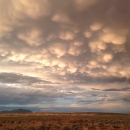States
OregonDefending and Growing the Core: Adaptive Management and Virtual Fence at Trout Creek Ranch
| Funding Year | Amount | Location |
|---|---|---|
| FY25 | $46,624 | Harney County |
Project Description
This project will design and implement an adaptive management program using virtual fencing at the Trout Creek Ranch, a 500,000-acre public-private working ranch in SE Oregon. The objective is to manage grazing to benefit/protect upland and mesic restoration project. This project will use virtual fencing to protect mesic restoration projects from grazing. Treating invasive annual grasses improves ecosystem resiliency in the face of climate change climate change
Climate change includes both global warming driven by human-induced emissions of greenhouse gases and the resulting large-scale shifts in weather patterns. Though there have been previous periods of climatic change, since the mid-20th century humans have had an unprecedented impact on Earth's climate system and caused change on a global scale.
Learn more about climate change , enhances public safety and community sustainability by reducing the threat of wildfire. Virtual fencing will also be used to manage invasive annual grasses.
Partners
The Nature Conservancy, Bureau of Land Management, Oregon Desert Land Trust

